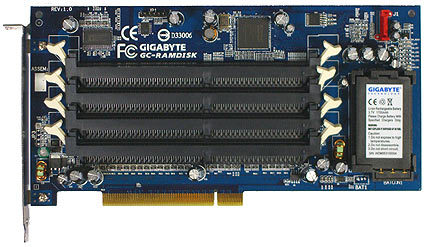Can Gigabyte's i-RAM Replace Existing Hard Drives?
i-RAM: Adieu Hard Disk?
In comparison with the throughput rates of other system components, those of modern hard disks still appear small, indeed. Especially in comparison to volatile memories (RAMs), access and transfer seems to take an eternity.
For years there have been attempts to speed up the performance ability of the ROM disk memory subsystem, because, with the exception of subordinate storage drives such as CD-ROM, DVD-ROM, diskettes or other exchangeable media, the hard drive is still the slowest device on a modern PC. It is not for nothing that the industry is trying to further increase the spin speed of hard disk drives for the long-term.
The usual solution to the problem up until now has been called the Solid State Disk, in other words a hard disk made completely of memory chips. Stand-out leading suppliers include U.S.-based Bitmicro and SolidData. While the latter concentrates solely on complete applications for professional customers, Bitmicro offers individual solid state drives that you can buy in retail channels - or at least in theory, since prices can quickly add up to several thousand dollars.
Solid State memory modules are used that are protected from data loss for a limited period of time through battery switching. Otherwise, without electrical charging the CMOS transistors in today's memory chips cannot retain their state. The result though is very convincing. Solid state drives are much more robust when it comes to vibration and, as expected, are many times faster than magnetic memory media - and we're talking about access here.
Taiwan's Gigabyte came up with an interesting idea, presumably while looking for new, attractive product ideas: What if you were to design a solid state hard disk out of normal memory modules? The result was the i-RAM, a board of medium size with four DIMM sockets, a buffer battery and a serial ATA interface. Power is supplied by a PCI plug, so you need to have at least one free slot, while the card requires the space of two expansion cards due to the size of the memory module on the side.
Get Tom's Hardware's best news and in-depth reviews, straight to your inbox.

Patrick Schmid was the editor-in-chief for Tom's Hardware from 2005 to 2006. He wrote numerous articles on a wide range of hardware topics, including storage, CPUs, and system builds.
